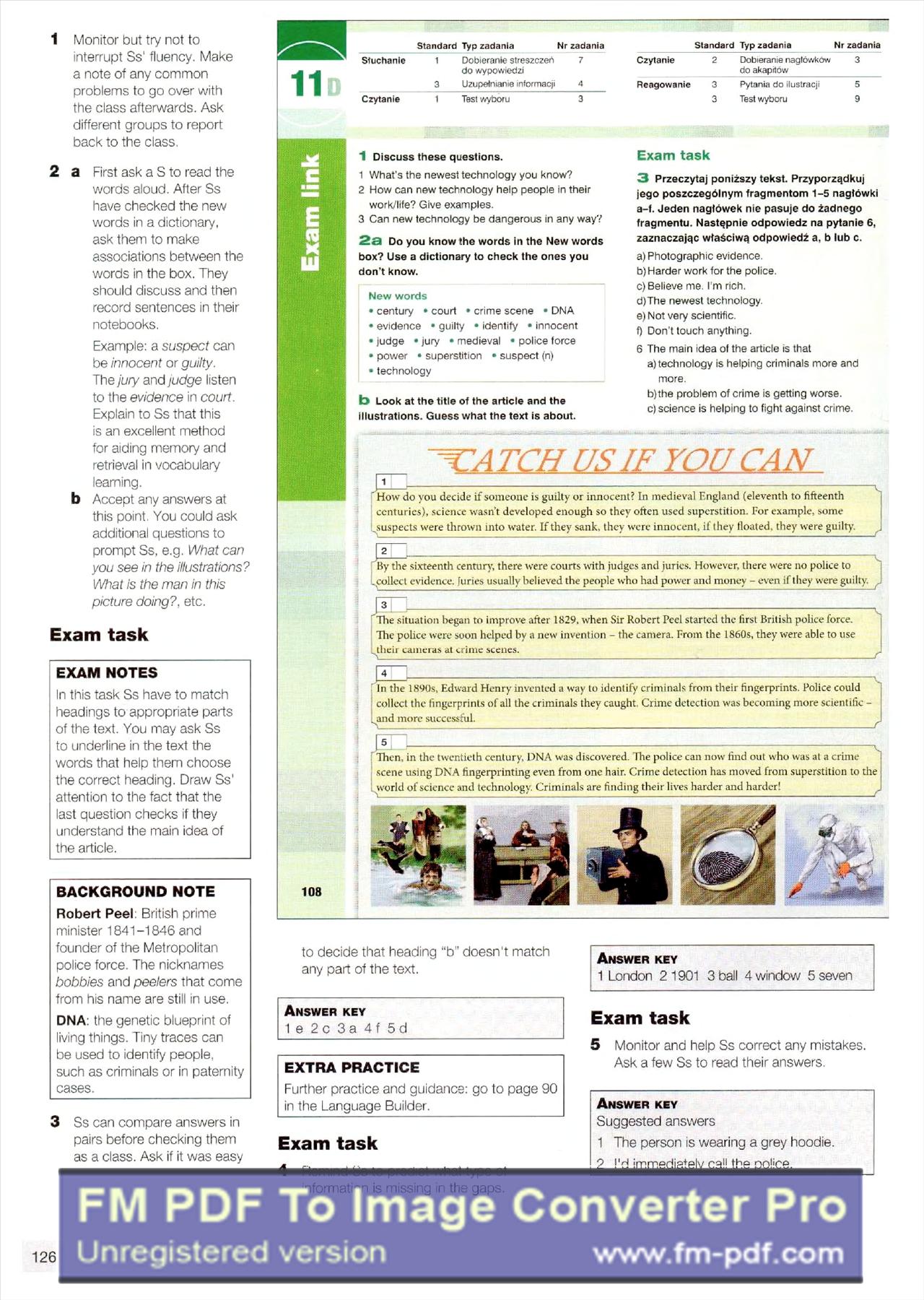Up¾at 3 Teacher's Book podrecznik nauczyciela plus odpowiedzi ,testy,klucz answer key Page 125

1 Monitor but try not to interrupt Ss‘ fluency. Make a notę of any common problems to go over with the class afterwards. Ask different groups to report back to the class.
2 a First ask a S to read the
words aloud. After Ss have checked the new words in adictionary, ask them to make associations between the words in the box. They should discuss and then record sentences in their notebooks.
Example: a suspect can be innocent or guilty.
The jury and judge listen to the evidence in court. Explain to Ss that this is an excellent method for aidmg memory and retrieval in vocabulary learning.
b Accept any answers at this point. You could ask additional guestions to prompt Ss, e.g. What can you see in the illustrations? What is the man in this picture doing?. etc.
Exam task

Standard Typ zadania
SÅ‚uchanie
1 Dobieranie streszczeń
do wypowiedzi 3 Uzupełnianie informacji
Nr zadania
7
4
Standard Typ zadania
Nr zadania
Czytanie
Reagowanie
Dobieranie nagtówkow do akapitów
Czytanie
Test wyboru
3 Pytania do ilustracji 5
3 Test wyboru 9
1 Discuss these questions.
1 What's the newest technology you know?
2 How can new technology help people in their work/life? Give examples.
3 Can new technology be dangerous in any way?
2 a Do you know the words in the New words box? Use a dictionary to check the ones you don’t know.
New words
• century • court • crime scene • DNA
• evidence • guilty • identify • innocent
• judge • jury • medieval • police force
• power • superstition • suspect (n)
• technology
b Look at the title of the article and the Illustrations. Guess what the text is about.
Exam task
3 Przeczytaj poniższy tekst. Przyporządkuj jego poszczególnym fragmentom 1-5 nagłówki a-f. Jeden nagłówek nie pasuje do żadnego fragmentu. Następnie odpowiedz na pytanie 6, zaznaczając właściwą odpowiedź a. b lub c.
a) Photographic evidence.
b) Harder work for the police.
c) Believe me. I m rich.
d) The newest technology.
e) Not very scientific.
0 Don't touch anythmg.
6 The mam idea of the article is that
a) technology is helping criminals morÄ™ and morÄ™.
b) the problem of crime is getting worse.
c) science is helping to fight against crime.

How do you decide if someonc is guilty or innocent? In medieval Fngland (eleventh to fifteenth ccnturics), science wasnt deyeloped enough so they often used superstition. For example, some suspects were thrown into water. If they sank. they were innocent, if they lloated. they were guilty.
By the sixteenth century, there were courts with judges and iurics. However, there were no police to collccl evidence. furies usually believed the people who had power and money - even if they were guilty.
108
Then, in the twentieth century, DNA was discovered. The police can no w find out who was at a crime scene using DNA fingerprinting even from one hair. Crime detection has moved from superstition to the world of science and technology. Criminals are finding their lives harder and harder!


The situation hegan to improve atter 1829. when Sir Robert Pcel started the first British police force. The police were soon helpod by a new invention - the camera. From the 1860s, they were able to use llicii camera* at crime scenes.
EXAM NOTES
In this task Ss have to match headings to appropriate parts of the text. You may ask Ss to underline in the text the words that help them choose the correct heading. Draw Ss' attention to the fact that the last question checks if they understand the main idea of the article.
In the 189()s, Edward Henry inventcd a way to identify criminals from their hngerprints. Police could collect the fingerprints of all the criminals they caught. Crime detcction was becoming morÄ™ scientific -and morÄ™ succcssful.
BACKGROUND NOTĘ
Robert Peel: British prime minister 1841-1846 and founder of the Metropolitan police force. The nicknames bobbies and peeiers that come from his name are still in use.
DNA: the genetic blueprint of living things. Tiny traces can be used to identify people. such as criminals or in paternity cases.
to decide that heading “b" doesn't match any part of the text.
Answer key
1 e 2c 3a 4f 5d
EXTRA PRACTICE
Further practice and guidance: go to page 90 in the Language Builder.
Exam task
5 Monitor and help Ss correct any mistakes. Ask a few Ss to read their answers.
3 Ss can compare answers in pairs before checking them as a class. Ask if it was easy
Exam task
Answer key
Suggested answers
1 The person is wearing a grey hoodie.
9 !'d immadiatplv ca!! the no!'ce.
126
Wyszukiwarka
Podobne podstrony:
Up?at 3 Teacher s Book podrecznik nauczyciela plus odpowiedzi ,testy,klucz answer key Page 036 Com 2
Up?at 3 Teacher s Book podrecznik nauczyciela plus odpowiedzi ,testy,klucz answer key Page 222 nice.
Up?at 3 Teacher s Book podrecznik nauczyciela plus odpowiedzi ,testy,klucz answer key Page 001 FM PD
Up?at 3 Teacher s Book podrecznik nauczyciela plus odpowiedzi ,testy,klucz answer key Page 005 Conte
Up?at 3 Teacher s Book podrecznik nauczyciela plus odpowiedzi ,testy,klucz answer key Page 006 Conte
Up?at 3 Teacher s Book podrecznik nauczyciela plus odpowiedzi ,testy,klucz answer key Page 009 FM PD
Up?at 3 Teacher s Book podrecznik nauczyciela plus odpowiedzi ,testy,klucz answer key Page 010 : Rea
Up?at 3 Teacher s Book podrecznik nauczyciela plus odpowiedzi ,testy,klucz answer key Page 012 Large
Up?at 3 Teacher s Book podrecznik nauczyciela plus odpowiedzi ,testy,klucz answer key Page 013 u mfo
Up?at 3 Teacher s Book podrecznik nauczyciela plus odpowiedzi ,testy,klucz answer key Page 014 selec
Up?at 3 Teacher s Book podrecznik nauczyciela plus odpowiedzi ,testy,klucz answer key Page 015 MMMMM
więcej podobnych podstron